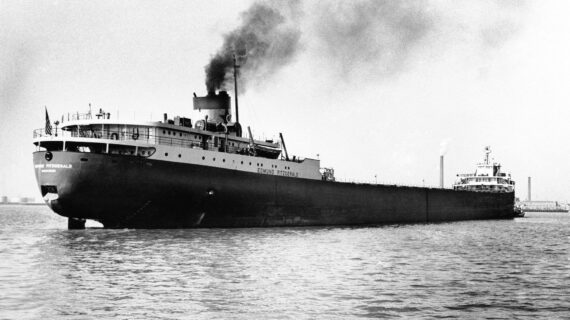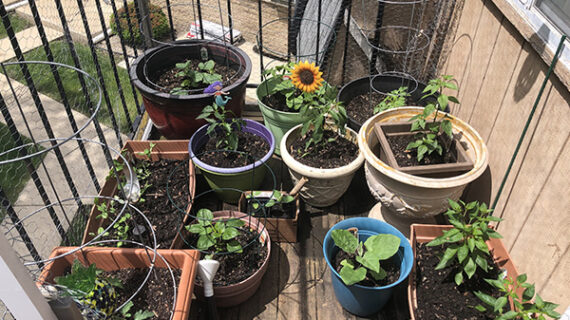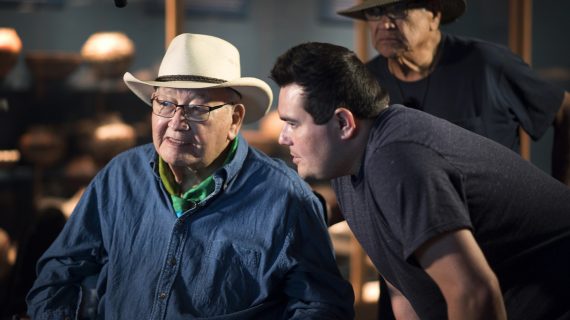[Tom Zinnen, Outreach Specialist, Biotechnology Center, University of Wisconsin – Madison]
Welcome, everyone, to Wednesday Nite @ the Lab. I’m Tom Zinnen. I work here at the UW-Madison Biotechnology Center.
I also work for UW Extension Cooperative Extension, and on behalf of those folks and our other co-organizers, Wisconsin Public Television, the Wisconsin Alumni Association, and the UW-Madison Science Alliance, thanks again for coming to Wednesday Nite @ the Lab.
We do this every Wednesday night, 50 times a year.
Tonight, it’s my pleasure to introduce to you Christy Remucal. She was born in Prescott, Arizona, and grew up in Taos, New Mexico.
And then she went to M.I.T. for her undergraduate in environmental engineering, went to Cal-Berkeley to get her PhD in environmental engineering, and then went to the Swiss Federal Institute for Technology in Zurich in Switzerland to do a post doc, and she’s been here at UW-Madison since 2012.
She’s here to talk about one of our favorite things, lampreys. She’s gonna talk about the environmental fate of lampricides in tributaries of the Great Lakes.
This week is the run up to Earth week, Earth Day, excuse me, and I think it’s a particularly interesting topic to think about what one of these special days sponsored and started largely by Gaylord Nelson of Wisconsin, how we look at things today compared to 1970 when Earth Day first started.
Please join me in welcoming Christy Remucal of Civil and Environmental Engineering to Wednesday Nite @ the Lab. Thank you.
[Christy Remucal]
Thank you.
(applause)
[Christy Remucal, Assistant Professor of Civil and Environmental Engineering, University of Wisconsin-Madison]
All right, is the volume is okay?
Well, thank you, Tom, for the invitation to be here, and thank you all. A really big thanks for coming out with the bad roads and weather.
Like I said, I had low expectations, but it’s really nice to see all you out here.
Is it okay? All right.
Right, so as Tom said, I’m gonna present some of our work looking at the fate of lampricides. Lampricides are pesticides which are used to kill the sea lamprey. So, I’ll sort of talk about why we use them and what happens to them once we put them out in the environment.
I’m coming from the Department of Civil and Environmental Engineering and I’m also in the Environmental Chemistry and Technology Program here at UW Madison.
And the project I’m gonna present is really near and dear to my heart. This is the first project I started when I came to Madison. So, I’ve been working on this for, I guess, the last six years.
So, to give you an overview of what I’ll be talking about, first I wanna set the stage and talk about lampricides, what they are, and they’re used to kill the sea lamprey. So, I’m actually gonna start by telling you a little bit about the sea lamprey.
How many people have heard of the sea lamprey before? Most of you, yeah, they’re, I don’t know, gross, scary fish. So, I’ll show you some pictures of them.
And then I’m an environmental chemist and so I really care about, you know, we put these chemicals in the environment and they do their job to kill this really nasty invasive species, and then I wanna find out what happens to them out in the environment.
And so, we’ll start simple. We’ll start with some experiments we did in the laboratory under very well-controlled conditions. And then I’ll take you out into the field.
Our group focuses on photodegradation. So, that’s how sunlight can naturally cause chemicals to break down, so this is a natural process. And that’s what we’re gonna focus on. And what we’ll see is that even though in the lab we can look at the chemicals degrading by light, we can identify the products, the chemicals they break – turn into, and what I’ll show you is that they can actually, they change from something that’s toxic to something that’s nontoxic, which is a really good thing. But when we move out into the field, sort of it is hindsight is 20/20. We picked our field sites pretty poorly. We didn’t actually see much photodegradation out in the field of the sites that we picked.
And we can explain it and talk about that, but part of this story is also some of the challenges when we go from our well-controlled conditions in the laboratory out into the environment and some of the other factors that come into play. So, if we knew now or if we knew then when we know now, we might have picked sites differently, but it’s still an interesting story to go through.
And we do think that photo degradation, so this natural break down by sunlight, is gonna be important in some systems, and we can kind of calculate how important it is gonna be.
I wanna start, I have a huge list of people to thank. This is really a team effort. The – the main person here is Megan McConville. She was my first PhD student in my lab. She’s actually holding a sea lamprey there and looking very happy about it for some reason. And then Laura and Natan are undergrads who contributed to this project. We also did a lot of work with U.S.G.S., particularly Terry Hubert. He was a really big asset in helping us really understand the system. And then, for the field studies, the two in the middle on the bottom, Steve and Shawn are – so US Fish & Wildlife is a group that actually goes and puts these chemicals in the water, and so we worked really closely with them on all the fieldwork, like in the middle of the night in the pouring down rain sampling with them, and we couldn’t have done this work without them. And then Adam is a hydrologist who helped with some of the modeling that I’m gonna show.
And then the – most of this work was funded by the Great Lakes Fishery Commission. This is the U.S. and Canadian agency that actually oversees the sea lamprey control program. This – this fish is a problem in both the U.S. and Canada, so it’s really nice that they work together, and they’ve been really supportive of our work. And then we also got a little bit of funding from Sea Grant and then the National Science Foundation.
So, I wanna start, I guess, by introducing you to the villain in our story, which is of course the sea lamprey. And you’ve probably seen pictures like this before. So, the sea lamprey is an invasive species. It’s found in all of the Great Lakes. And there are a lot of invasive species in the Great Lakes. You hear a lot about different species. And the reason why the sea lamprey is such a big deal is because it’s a parasite. And so, it preys on large fish, like lake trout, walleye, catfish, and so on. And you can see in this first picture there’s those like sucker-like fish, and they basically, you know, attach to fish. And you can see on this picture there are actually some wound marks from where the lamprey attached. And this obviously can be lethal in many cases for the fish. And this has been a really big deal for harming fisheries, and that’s why it’s real important to control the population of these fish.
The sea lamprey have been around for a really long time. So, they came in through shipping canals, so from the Atlantic Ocean. So, they were first found in Lake Ontario in the 1800s, and then, as we opened up more and more shipping canals, they kind of made their way westward. And so, they were found in Lake Eerie in 1921, and then they made their way westward. So, they were found in Lake Superior by 1938. So, they’ve been around for a really long time.
And one of the reasons we care about this is because of their impact on the fisheries, especially the large commercial game fish. What I’m showing here is data that shows the commercial lake trout harvest with time, in Lake Superior on the top and Lake Michigan on the bottom. And you can see up until about the 1940s or 1950s there was a pretty nice, stable harvest, and then there was this big plummet that came down. The populations basically crashed. And so, I marked here in red the years when the sea lamprey were first detected in each of these lakes, and then about a decade, 10 to 15 years later there was this big crash.
And I don’t want you to think that the sea lamprey were the only thing that caused the crash of the fisheries. There were other chemical stressors and other – other issues going on as well, but the sea lamprey definitely contributed pretty heavily to the decline of the fisheries during this time. The good news, though, is that if you look further out with time, you can see the fisheries, I mean they’re not back to where they were, but they’ve definitely been steadily improving. And the sea lamprey control program has actually – it’s actually really effective at maintaining the population of the sea lamprey at sort of a low level as best they can. It’s been really successful, and that’s helped the fisheries to come back.
So, I’m gonna talk, I’m a chemist but I need to talk a little bit about the fish biology just because it’s really important to know that – to know why they do the sea lamprey control the way that they do. And so, this is, yeah, sort of the life cycle of the fish. And so, they start out down here at the bottom as larvae. And this is a picture that we took up at U.S.G.S. in La Crosse. And they’re sort of these work-like little creatures. They live in the sediments. They start out their life and they’re not parasitic, so that means they’re not gonna, like, attach to larger fish.
After several years, they undergo a transformation or like a metamorphosis, and that’s when they get like the big, scary teeth. And then, at that point, once they’re parasitic, they go out into the Great Lakes where they feed on large fish. And then they’re like salmon. They – they go, return to the tributaries to spawn. They’re not pick – picky. They’re not like salmon in that they always go to the same place. They can go to any tributary they want to, which actually makes it kind of harder to control them in a way. But they do return back to the tributaries to reproduce.
And so, the tributaries I guess I should define. Those are all the rivers that feed into the Great Lakes. And they spend a lot of their life in those rivers. And so, for that reason, all the efforts to control the population of the sea lamprey focus on the rivers, on the tributaries. And that’s because they’re sort of in a more contained area, and that’s also where they spend when they’re larvae. So, that’s when they’re most vulnerable, at least for the chemical stressors. And so that’s why the sea lamprey control really focuses on those tributaries.
Now, to give you a sense of scale, how widespread these fish are, this is a nice map put together by Mike Siefkes, and every dot on this map shows a tributary with a known sea lamprey population. So, you can see that it spans both the Great Lakes in the U.S. and in Canada. There are total around 450 tributaries that have sea lamprey living in them. This is about, there are about 5,000 tributaries all together, so this is about 8% of the rivers around the Great Lakes have a sea lamprey infestation. So, this gives you a sense of scale and why it’s really important that both U.S. and Canada work together to control these fish.
As far as sea lamprey control goes, there are a bunch of different things that are used. First of all, you can put in barriers to prevent migration. So, the fish, when they’re gonna reproduce, they swim upstream. So, if you put up in a barrier and they can’t go upstream, they can’t go upstream and reproduce. Of course, this will prevent any native fish that also need to go upstream, so you have to be careful about that. And there’s work done on like sort of how to be more selective about which fish can go upstream.
You can actually go out and physically trap them, the larger fish, and catch them and kill them, so they do that in some instances. They also sometimes will release sterile males, so try to decrease fertility by putting out male fish that can’t reproduce.
There’s some really interesting work going on now with pheromones. Pheromones are chemicals that the fish can smell, and they actually have identified pheromones that the fish really like and that the fish really don’t like. I think they take like dead sea lamprey and it’s like a dead sea lamprey extract, basically. But it’s, you can think about you might put a chemical that they like in one stream and a chemical that they don’t like in another stream and make them all go toward, you know, one spot and then you can trap them or do something else. And this is not really widely used yet, but it’s sort of up and coming and like where the – a lot of the research is on new directions for sea lamprey control.
And then, last but not least, is what I’m gonna talk about, which are the lampricides. These are the two chemical pesticides, and these are the most widely used. They’ve been used a really long time and they’re used all around the Great Lakes and they – they’ve been really effective.
So, let me, I guess now that we know a little bit about the fish, I wanna show you a little bit about these two chemicals. And there are two of them. And so, like I said, adding a lampricide is the most common way to control the sea lamprey, and there are two.
So, the one that’s in blue here, 3-trifluoromethyl-4-nitrophenol, which I’ll just call TFM for short because that’s just easier. This chemical is pretty interesting. We started using it in the 1950s. So, it’s been put in our waters for a really long time. And it’s considered to be selective for the sea lamprey.
So, back in the 1950s, they tested thousands of chemicals on sea lamprey and also on native fish. And TFM they found was really good at killing the sea lamprey and less, not as toxic for native fish. And this has to do with the fact that, again I’m – Im not a biologist, but the sea lamprey are really ancient species and they dont have the – they’re not able to get rid of the chemical, and so it is able to kill them pretty effectively.
So, TFM is added pretty much at all streams where they’re adding these chemicals. It’s added all the time at a rate of about 50,000 kilograms per year, which is a lot. I’ll show you some pictures here in a minute so you can kinda get a sense of the scale. In total, they treat about 120 tributaries every year in the U.S. and Canada. Usually on a three- to four-year cycle, and that’s because of the life cycle of the fish. So, they’ll treat a river and then three or four years later they’ll come back and treat it again, usually.
So, TFM is selective. It’s used everywhere. And then in some tributaries they also add the chemical that’s in orange, which is niclosamide. I’m not gonna bother with the whole chemical name ’cause it’s really long.
Niclosamide is added as a percentage by weight. So, about 1% by weight with TFM in some tributaries, usually in the really large river systems or in areas where the water is moving really slowly. So, it’s not added as often. It’s added in a lower concentration, and that’s probably a good thing because this chemical is an active ingredient in Bayluscide, which is for killing mollusks. So, that kills other kinds of organisms as well. And so, it’s not gonna be as, it’s gonna be more toxic to non-target organisms, things that they’re not trying to harm. So, well – I’ll talk about both of them, but it’s important to remember that TFM is the one that’s used the most. It actually degrades the most quickly too, which is a good thing.
So, I wanna show you some pictures so you can kind of envision this. I really, before I started working on this, really didn’t have a good appreciation of the scale of what one of these treatments looked like. It’s really, really impressive, especially when you’re out on a really big river. So, first of all, this is the kind of trailer that they carry the chemicals around in. And so, you can just imagine like driving down the highway next to this trailer. It’s pretty amazing. You know, they have their fish on the side, the lamprey on the side of a fish, and then all the big sucker mouths on the side. But these are the trailers that they haul chemicals around in.
This is a huge operation. So, this is from the Manistique River up in the upper peninsula of Michigan, I guess about a year and a half ago now. And the – the fisheries – I’ll show you a map a little later, but it’s such a big operation. They pretty much filled up every hotel in town with people working on this. Like, it’s – its a big deal.
And this is kinda what it looks like. So, these are toxic chemicals. You can see on the picture on the left, you know, it’s a toxic chemical, it’s a pesticide. It’s labeled toxic with, like, a skull and crossbones. And then, the bigger picture, there’s someone from Fish & Wildlife that’s pumping those chemicals into the river. And I think at that site, this was just a small tributary, it was something like eight or nine of those cans an hour being pumped into the river, which is pretty impressive to see.
And then in some cases, you can actually see it in the river. It’s maybe a little hard to see in here, but you can see there’s like the little bit of yellow splash where the chemical is being mixed in. And then, yeah, it goes and does its thing. And the way that they add it they’re trying to get acute toxicity, which means they wanna kill the fish right away. And so they – they add the chemical in like an eight or nine hour block, and they try to make sure the chemical concentration is the same for eight or nine hours and then they turn off the switch and they’ll come back three or four years later is kinda how it works.
And if you can imagine like a really big river system, like maybe if you have two rivers coming together, they’ll add the chemical and they have it all worked out, so the chemicals come together at the same time. It’s, like I said, a really impressive operation, and they’re actually out there in the field in real time measuring the concentrations, the amounts in the water, to make sure it’s the – the right amount. So, they’re adding what they need to achieve toxicity but not too much that they harm native, other fish. So, like I said, it’s really impressive and I really didn’t appreciate – appreciate it till I got to go out and see it.
So, as a chemist and now as an environmental engineer, you know we put these chemicals in, there’s obviously trade-offs of doing that. The sea lamprey are – are a really, you know, big deal and important to control. But the chemist in me and the engineer in me is like, okay, so what happens to the chemicals after they’ve done their – their thing? Where do they go? And so, what we knew when we started this project, I mean they’ve been used for a long time and there’s been a lot of work done on them, so we knew some things to start.
First of all, neither chemical undergoes hydrolysis. This is a transformation process that happens when the chemicals react with water. A lot of pesticides do this. These chemicals don’t. So, they’re not gonna spontaneously break down. They’re gonna be pretty stable. Neither chemical is volatile, which means it’s not gonna go into the air. It’s gonna stay in the water. Or it can go into the sediment, so into the soil. For niclosamide, the one in orange, it’s a little bit of a bigger chemical, so it’s gonna be more sticky. It’s gonna associate with the sediment more. Whereas, TFM is gonna pretty much stay in the water. So, we’re gonna add it to the water and it’s gonna stay in the water.
They do undergo biological degradation. So, some types of bacteria can make them break down under some conditions. And there’s some work still being done to learn more about that process. And then when we started this project, we saw that there were a couple papers suggesting that degradation by sunlight or photo degradation was important. And, again, this is, yeah, sunlight causing the chemicals to break down.
And so, to tell you a little bit more about that process, this is my photochemistry 101. Pretty simple, this is the Manistique on the one day it was sunny, which was one of the reasons why we didn’t see much photo degradation there it turns out. But the idea here is that we have our sun, the chemicals absorb light. They – I’ll show you their spectrum in a minute. They overlap with the solar spectrum, and it’s possible that they can fall apart into chemicals that, you know, we actually characterize those and we found out that they’re ones that are not gonna be as toxic, which is a good thing.
And so, I guess, let me show you a little bit more about what they look like. So, this figure here, let me walk you through it, is important. So, the dark blue line shows the solar spectrum. This is the wavelengths of light that are coming into the Earth. And so, what you can see is that starting at about 300 nanometers and up, those are the wavelengths of light that the sunlight that hits our Earth. The lines in orange and blue are the absorbent spectra of TFM and niclosamide. These are the wavelengths of light that those chemicals absorb. And the main point here is that there’s a lot of overlap between the chemicals UV-vis spectra and the solar spectrum. And so, to put that another way, that means they – they overlap with the incoming light so they can absorb light and they can break down, potentially.
That’s sort of the first rule of photochemistry. If those two curves didn’t overlap, there’d be no possible way of having photo degradation at all. So, we knew this sort of coming in that they do absorb light. And we also knew a little bit more about their behavior from some older studies, so one from 1981 and one from 2004.
And so here what we knew from these works – these works, again there’s sort of my cartoon where we have sunlight reacting with our two chemicals causing them to break down. We knew that this process depends on the pH, so that’s, like, the acidity of your water. Most waters, rivers are gonna be around a pH between six and eight, usually more like seven or eight, so that’s like neutral pH. But if you had the pH higher or pH lower, how quickly these chemicals are gonna break down is gonna change.
We also knew something about their half-lives. And this is a term I’m gonna use quite a bit. And so, a half-life is the time it takes for half of the chemical to go away. And so, if you have something that has a half-life of a minute, that means it’s gonna go away really quickly, and if it’s something with a half-life of five days, that’s gonna take a really long time. So, I’m gonna use half-life, again, as sort of a way to measure how quickly these chemicals are breaking down.
And so, we knew, this is actually from the 1981 study, that that half-life of TFM, and again that’s the chemical that’s more specific for the sea lamprey, it’s used in higher concentrations. These researchers thought it would go away on the order of a few days, so that’s kind of a long time. Whereas niclosamide, the one that isn’t used as often, they said it was gonna go away on the order of seven to thirty hours, and that was under their experimental conditions. So, you can think back, we – we know when we go from the lab out to real conditions, things are different, and we actually found that this was quite different in practice.
So, we knew a little bit. We know enough to say like, okay, this is probably important. We didn’t know much about what the transformation products were, so what they break down into. And this is important to understand because there aren’t very many examples but there are some where a chemical undergoes photo degradation and it actually forms something that’s more toxic than what you started with, so that would not be good. So, we wanna make sure that once it does break down, it’s forming things that aren’t gonna be harmful.
So, we didn’t know that, and we – no one had ever looked at these two chemicals under the same conditions before. And there were – there were some room for – for adding a little bit more here. And we actually learned a lot.
So, I mean, you know, you all live in Wisconsin, you know what it’s like, and so we do our experiments in the lab for starters. And this is a picture of our merry-go-round photo reactor, so it’s like a little merry-go-round. You can see in the middle; you can see these are all test tubes in here and that the little thing spins around. So, that’s why it’s called a merry-go-round. And on the outside, we have all different light bulbs. In this case, we’re using light at 365 nanometers, which is in part of the solar spectrum. And it’s fun ’cause it’s a black light, so that’s pretty much what it is, so that’s kind of fun too.
But yeah, this is how we do our experiments ’cause we can put a whole bunch of test tubes in there, and test a lot of different conditions, do a lot of different replicates, and, like, it’s the same every day. So, we can do these experiments when the weather is like it is today or in the summer, any time.
So, we – we did this and the first thing we looked at was just when we shine this light on these two chemicals, how fast do they go away? Just, as a first cut, wanting to verify what was already known in the literature.
And so, yeah, this is what this figure shows. And so, on the x or y-axis, this is a rate constant, so this is how quickly it goes away. So, things that are higher up, they’re going away quickly, and things that are lower down, they’re going away more slowly. And so, we can see a couple things. First, with TFM, and this is all plotted versus pH, so the acidity of our water. And, again, most waters are gonna be around pH seven.
With TFM, as the pH goes up, the chemical degrades more quickly. So, and it changes a lot depending on the pH. And niclosamide had the opposite trend. So, their behavior is gonna be different. So, as the pH goes up, TFM is gonna degrade more quickly, whereas niclosamide is gonna actually slow down.
So, that was one thing that we – we knew, or we learned. And the other thing was that, like I said, no one had ever looked at these two chemicals under the same conditions before, even though they’re added together so you’d think it would be good to look at them together. And we can see there’s a really big gap between those two curves. And what this means is that TFM is gonna go away much more quickly than niclosamide. And TFM is the one that’s used in higher concentrations, it’s more selective for the sea lamprey, and so it goes away much more quickly. Whereas niclosamide, which is harmful to other organisms like mollusks, is gonna go away much more slowly. And this sort of contradicted the earlier study. And that was a bit of a surprise.
But I think, yeah, we – we learned a lot from this. This was really valuable to find out how quickly they go away.
These are our lab conditions. And, you know, those – those black lights are obviously not what sunlight looks like, but we can do the math and kind of calculate how quickly these will go away under actual sunlight conditions. And so, I apologize for showing a table, but it kind of gets the point across.
So, what I’m showing here is the half-life. So, again, a smaller number is better. We wanna have a half-life being short ’cause we want it to go away. For TFM, looking just at the surface of the water, like, if you’re looking at the very top that’s getting the most sunlight, it’s gonna go away on the order of a couple hours. Whereas niclosamide, even at the very surface of the water, it’s gonna go away – go away on the order of a day or longer. And this is assuming that the sun is on at noon all the time, which is obviously not accurate.
As you can imagine, though, this is looking at the surface of the water, and as you go deeper in the water, obviously it gets darker. And it turns out the light actually drops off really quickly. And so if we – if we do the same calculation over, like, 55 centimeters, now we can see TFM is gonna go away on the order of 20 hours, or something like that, and niclosamide we’re talking hundreds of days, which is, you know, obviously the water is not gonna stay in the river for hundreds of days so that’s not very practical.
So, what we learned from this, and I’ll show you the data, a little more data on niclosamide, but we basically learned that from a photochemical degradation perspective that’s really probably only gonna be important for TFM. And that’s the one that’s more selective, it’s less persistent, and it’s added pretty much everywhere. Whereas niclosamide, which is less – less selective, it’s gonna stick around a lot longer in the rivers.
So, we – we know about the rates, and we can make good calculations about how quickly they’re gonna go away. The other question is to figure out what they degrade into. For both of them, we found that they’re gonna degrade into things that are gonna be less harmful, which is a really good thing and that was really good to learn.
And so, believe it or not, I did try to simplify this a lot ’cause it’s really complicated, but the basic idea is we start with TFM. The main product is this – this chemical called gentisic acid. And there, I think we detected, we quantified, I don’t know, maybe four or five other chemicals, and we identified a lot of other chemicals. It – it basically makes a whole soup of different things.
But what’s important is that if we look at TFM, it has this fluorine in it, that’s the F, and this NO2 group, the nitro group. Those are both signs that a chemical is gonna be really persistent. And I’ll show you in a minute that things that have fluorine or chlorine on them are really common in a lot of contaminants that we worry about. So, the fact that we’re losing those chemicals is a really good thing.
And I guess to show you some more data what this actually looks like in practice, we did a bunch of modeling and we could see that the blue is showing TFM going away. We could see gentisic – gentisic acid forms, and it goes away as well ’cause it also undergoes photodegradation. And that’s part of what – what makes understanding the chemical mechanism really complicated is because all of the products also photodegrade, so they form and then they go away. And so, we have a whole bunch at the bottom that are really low concentrations because they form, and they go away so quickly.
And then what I think is really important and that I wanna emphasize is that we do form fluoride. So, that’s like just a salt, that’s not harmful at all. But we’re losing our fluoride from our floral methyl group here. And we can actually see production of fluoride coming in, which is really a good thing.
Niclosamide, I’m not even gonna show you any of the organic products ’cause it’s like a mess. We quantified, I think, something like nine different chemicals and then identified the molecular ways of something like 30 more. It, basically, the chemical falls apart right in the middle of the chemical and it makes a whole bunch of different things, but, again, it’s losing the chlorines, which I circled in red up there. So, we can see the formation of chloride here. So, it’s losing those two chlorine atoms. And then we can see the formation of nitrate which is coming from this nitro group here, and that’s a really good thing. Those – those chemicals, the chlorine and fluorine are markers of really, kind of, persistent chemicals. I actually wanna take a little bit of an aside and kinda show you a little bit about that.
So, the halogen group is in the seventh group of the periodic table. It’s the one I have circled in the box. So, we start with fluorine, chlorine, bromine, iodine. These are really electronegative atoms, and they form really polar bonds. And it’s – its really kind of hard to break those carbon halogen bonds. And we see these chemicals, these – the – these halogens in a lot of chemicals that are, like, kind of, our classic contaminants or even newer contaminants. Whenever you see halogens in a chemical, you’re like that’s probably not a good thing. It’s usually gonna be toxic. It’s usually gonna be persistent. And so, I can give you a few examples here.
So, there’s a lot of good examples of chlorinated compounds. So, a good one is DDT. Who’s heard of DDT before? Probably everyone, right? So, it was around – it was around a long time. We don’t use it anymore, which is a good thing. But this is the insecticide that Rachel Carson wrote Silent Spring about. So, Silent Spring, the title refers to a spring where there’s no birds because this insecticide has killed all the birds. So, this is a really harmful one.
PCBs, polychlorinated biphenyls, these are used in coolants. They’re also not used anymore but they’re really persistent. You can still find them in the sediments of the Great Lakes because they – these really stick to the sediments. They’re still around. Theyre – theyre – they last a really longtime. PCE, this is used in dry cleaning. A lot of times dry cleaning fluid leaks underground, so we find these chlorinated solvents in our groundwater frequently, and they’re also really persistent. These chemicals are really common in the environment. But you know, you can see they all have those halogens in them.
These are kind of what I call classic contaminants, and then they’re also emerging contaminants. I don’t know why we call them emerging contaminants. We’ve been studying them for a while now. But these are chemicals that we, people in my area are really interested in looking at right now. And so, we can show examples of brominated compounds like this polybrominated diphenyl ether, PBDE. These are flame retardants. These are added to like couches and furniture and things like that at kind of shockingly high concentrations. I don’t know, if you look at them it looks a lot like the PCBs except they have that oxygen there in the middle. But it’s, I don’t know why we thought this was a good idea I don’t know because they’re pretty toxic and they’re really persistent and hard to break down.
And the fluorinated compounds, I put up a couple, PFOS and PFOA. These are really interesting looking chemicals. These are used, or were used, they’ve just phased them out in like Scotchgard and things like that. They’re also used in firefighting foams like at airports. And these are, you’ll see, if you pay attention to these, you’ll see these in the news a lot for contaminating groundwater recently. These are sort of a hot topic at the moment.
But I wanted to just talk about this because if we think about the two chemicals that we’ve been spreading, these lampricides, you know, niclosamide has two chlorine atoms on it, TFM has three fluorine atoms on it, and the fact that those halogens are going away when the chemical does undergo photo degradation is a really good thing. The chemicals that it turns into are gonna be ones that are gonna be easy for bacteria to eat. They’re basically food at that point. They look pretty tasty to bacteria. So, once they lose these halogen groups, they’re not gonna be things that we’re worried about. So, even though the rates, especially for niclosamide, are quite slow, once they do break down they’re gonna form things that we’re not concerned about. And so that was really good to learn that.
Okay, so we did this work looking at what happens in the lab where things are very well behaved. And then we wanted to find out, does it happen in the field? And sort of like I said at the top, you know, hindsight is 20/20. We might have picked different sites if we’d done this again, but it was, you know, it’s all sort of happening at the same time. And so, we went to three different sites, two in 2015 and two in 2016.
And so, in 2015, these were tributaries that are, they’re actually, this – this bottom map shows all three sites on the same scale. So, here are the first two that I’m gonna show. They’re really tiny. They barely show up there at all. And then here’s the Manistique, which is huge. And this is the one that I said they filled up like every hotel in town because there’s so many people working on this.
For these two small sites, these are really simple. Basically, what they’re doing up here at this upper, where that green dot is, they add the chemical once and then the chemical just goes downstream. So, they just add it in and that’s it. They just leave it alone.
So, what we did here on these two sites, we sampled just downstream. This is our upstream site. We sampled just downstream of where they added the chemical. And then we sampled as close as we could get to the river mouth. And what we also did in parallel to this, we added sodium bromide, which is a salt; it’s a tracer. And so, this basically lets us quantify or measure how much water, where the water is going in this system. And so we measured the bromide at the top and the TFM at the top of the water, the reach, and then the bromide and the TFM at the bottom, and we could calculate how much was lost over and see, like, do we see any loss due to photo degradation?
And so, we did that at these two sites. Ill – I’ll say – say a little bit more about that in a minute – in a minute. And then, in 2016, we went out on the Manistique River, and this is a huge river. Every one of these, I know it’s a little small, but every one of these green points is a point where they’re adding chemical. And, again, think of that they’re wanting to get all the chemical, by the time it makes its way to the mouth, all the chemical and all this side tributaries are wanting to come together at the exact same time in the exact same concentration. So, it’s – its an amazing operation. And then every white dot on the figure, that’s where they’re out and they’re actually measuring the chemical concentration in real time.
And if the chemical concentration is too low, they’re gonna add a little bit more in to make sure the concentration stays the same. So, this is a huge operation. And so, for the first, the two smaller tributaries, they only added TFM. TFM is often added only by itself. And in this bigger river system, they’re adding both TFM and niclosamide together, so they’re measuring both in the field.
So, I’m gonna show you the data from these first two smaller tributaries first. And, again, I’ll show you some more pictures. This is someone from Fish & Wildlife who’s actually setting up to put the chemical in. You can see this is a really small tributary. You can kind of see it’s maybe a meter or so across. Down here on the bottom right there’s this can of TFM and this toolbox that’s basically a pump, and it’s pumping the chemical out. He has like the little drip line. They sort of picked a reach where there’s a little bit of turbulence to kind of mix up the chemical and get it distributed across the river, but that’s pretty much it. He’s gonna set this up, he’s gonna let it run for about 10 hours, and then that’s it for this site.
We added, we actually went, we had to do it on a different day because they wouldn’t let us add the bromide on the same day. We went back the next day. Here, that’s, yeah, very fancy field equipment, a trash can which we filled up with this salt, this sodium bromide, mixed it up with a big stick, and then poured it in the river all at one shot. And then we had our poor students downstream rapidly collecting samples as quick as you could so we could really capture those chemicals and see what happened.
And so, this is what the data looks like. So, on the top, this top panel shows the TFM concentration and the bottom shows bromide. So, the lighter colored blue, this is the – the TFM concentration measured right downstream of where they added the chemical. And you can see, okay, nothing’s happening. Well, I guess my students slept in a little late that day, they didn’t get those first couple points. But you can imagine nothing’s happening, and then they turn the chemical on, it’s staying steady concentration, around 20 micromolar for about 10 hours, and then they stop pumping in the chemical, and then it drops off again.
And then we went downstream as far as we can, and we measure the chemical. We can see it’s starting to come up, concentration’s lower. It lasts for about the same time. And then the chemical goes away again once they stop adding it.
So, then we did the same thing with bromide, and this is one that we, like, dumped the trashcan of chemical into the water. And this is a salt, it’s just a harmless tracer. When we measured downstream, you can see we see a huge spike of the chemical from dumping in the whole big bucket. And that’s, you know, reaching concentrations of around 700 micromolar. And then, looking downstream, you know, things sort of spread out. You know, things aren’t moving down in a nice, neat block. Things diffuse a little bit. But we can measure the chemical at the bottom.
And this is really useful to us actually to collect the data at the top and the bottom ’cause we can do is, basically, calculate the area under that curve and calculate how much mass we had at the beginning. Like what was our total mass added versus our total mass that we’re measuring at the bottom. And the reason we did the tracer is because the – the sodium bromide tracer we know isn’t gonna undergo any chemical reactions. It’s only gonna move with the water.
And we know if you imagine water flowing downstream, it can – some of it can actually go into the ground, into the hyporheic zone, and that’s actually what we saw. So, what we saw was about, looking at the tracer and comparing the areas under the curve, we lost about 30% of the mass that we added to this exchange with the groundwater.
Looking at the areas under the TFM curve, we saw we lost 34% of the TFM. And with an error, those are pretty much the same number. And so, what this means is that any TFM that we lost, any of the lampricide that we didn’t measure at the bottom that we added, that’s because it’s also going into the groundwater, the same as we saw with the sodium bromide salt.
And then, because we had done all the work to identify all the possible degradation products, we could look for them, and we didn’t find any. So, both of those two things together told us, like, okay, we didn’t see any photodegradation. Well, okay, but we’re sure that we didn’t see it. We have those two ways of sort of telling that.
Looking at Sullivan Creek, the other really small tributary is the same. You can see what it looks like. It’s a little bit of a bigger, a little bit bigger, but it’s still pretty small, really forested and really beautiful up there on the UP. And the data is really similar where we – we have the top panel that shows TFM, you know, higher concentration of the upper stream, and then it decreases on the lower stream. And then we did our sodium bromide tracer test again here. And I didn’t put the percentages up there, but, again, they were basically about the same where the amount of salt that we lost in our tracer test was the same as the amount of TFM that we lost in the actual chemical application of lampricide.
And so, again, we didn’t see any photo products here. And so, we’re like, okay, we didn’t see any photodegradation. At the same time we sort of worked out all of our, you know, measurements in the lab, and we’re all like, okay, well, we probably should have known that because the residence time, so the amount of time that it takes from when we add the chemical to when it reaches the Great Lake, Lake Superior, is about one hour – one to four hours, depending on which river we’re talking about. And our half-life, so the time it takes for the chemical, half of it to go away is 12 hours. So, in retrospect, that’s not really a surprise. We probably should have known that. But, like I said, that’s – thats part of the challenge. And so, we’re like okay, well, this – this river was really small. We want something where the chemical is gonna be in the river for a really long time. And so, we went to basically one of the biggest river systems that they treat, which is the Manistique River.
And I showed you this map before, and, again, with the Sullivan Creek and Carpenter Creek, those two little rivers I showed you, I guess creeks, they don’t really count as rivers. They’re really small. Those are up there on the same scale. And then here’s our Manistique River which is, I mean it pretty much goes across the whole UP. It’s – its really big, and it’s a really wide river. It’s not as shaded. And the chemical from the time it’s added at the most furthest upstream point to the time it makes it all the way down is three – over three days. So, we’re like, okay, three days, you know, we’ve done our math, you know, we think you should see something here. And so, what we did here, we didn’t sample the whole thing. This was a huge operation. We sampled it where all the blue triangles are.
And so, we could basically follow the chemical block as it was moving downstream. And one thing to remember here is that they’re – theyre working really hard to make sure the chemical concentration is the same throughout the whole river. Again, at all those white dots they’re actually out in the field measuring it and then adding more chemical as needed.
So, to show you some more pictures of what this river looks like. First, we’re gonna look at the Cookson Bridge, which is the site we have labeled here M1. This was the furthest upstream that we – site that we sampled. You can see this is a really, really wide river. There’s a whole bridge across this. What they did, basically, at this site, this was a boosting site. So, they were actually there measuring the chemical concentration and saying like okay, it’s a little lower than we want. So, they’re adding in a little bit more to kind of bump it up.
So, they had the chemicals here at the bottom. There’s a pump, and then they have this, like, drip line that they, I think the Fish & Wildlife actually in this picture is trying to get this drip line across the river, they could drip the chemical in. So, that’s – thats what they were doing there. And then there’s my student, Megan. We were, you know, sampling over the bridge, throwing in a can or a bucket and pulling up a sample. And she’s holding a big sonde, which is this big instrument, it has a bunch of measures, temperature, pH, and a whole bunch of things in real time. So, we’re doing a bunch of measurements there off the side of the bridge.
And then this was like, so I’m a chemist. I like to stay in the lab. I don’t like to do fieldwork. But this was really nice fieldwork because the lab kind of came to us. And so, this is a Fish & Wildlife mobile analysis trailer, which was really nice ’cause this was midnight in the pouring down rain, so it was really nice to have a nice place to go inside. But they have these, like, trailers that are basically like mobile laboratories that they take out on these big field sites, and they’re actually measuring these chemicals, like, in real time.
This one, this instrument here, this is a UV spectrometer. This is for measuring TFM. It’s in a higher concentration so they basically just, it basically takes advantage of that UV-vis spectra that I showed you. They shine light on it, they can measure the concentration. And then this is a more, a fancier instrument. It’s a high-performance liquid chromatograph. This is for measuring niclosamide. And so, Steve Lantz, I showed you a picture of him at the beginning, he – he was out there in the middle of the night measuring the chemical concentration, making sure that what they were adding was right, and there was a couple poor guys in boats in the pouring down rain downstream collecting samples and bringing them back. And you can just imagine it was a good bonding experience, being out there for it.
But – we – it was pretty interesting to see. And this is what the data looks like. So, let me walk you through it. The top is TFM, the bottom is niclosamide. In this we’re looking over several days. Again, remember, this is a multi-day treatment process. It lasts a really long time. So, we have, this is our first site. We can measure the TFM, and we’re basically following that chemical block kinda as it moves downstream what’s going on. And then niclosamide is at a lower concentration. It’s a lot messier and that’s because it sticks to the sediments and so it’s a little bit less behaved, less well behaved. We can see it.
And then we wanted to look for photo products, the transformation products, and we didn’t find any, which was a bummer. My poor grad student was really sad when we got this result. We didn’t find any. And the question was, why? You know, we’re thinking the half-life is something like 20 hours and it was there for three days. Well, the environment is a messy place, it’s a lot more complicated than we think it’s gonna be, and so we can actually adjust for it. And so, well, you can see I’m gonna walk you through that. And this half-life is gonna get bigger and bigger and bigger as we go. But our initial estimate was about 20 hours.
And we look and say, okay, well, first of all, that’s not really a good estimate because this is assuming that the sun is on, like, noontime conditions all the time, which, obviously, the sun is not shining 24 hours a day. And we’re looking at a depth of 55 centimeters. So, actually the first thing we looked at was, well, that’s a really deep river. It’s about two meters deep. So, if we, and this figure shows like how quickly light drops off with depth. And so, thinking about how deep the water is is really important. So, if we go from 55 centimeters to two meters, that triples the half-life, so the chemical just over in a deeper water is gonna go away three times more slowly. And then Madison is not Manistique and the UP. So, the sun’s, you know, the sun is at a different angle, so we corrected for that. So, you can see the – this is our sunlight data. This is what Madison is. It’s basically higher, getting a little more light for that first calculation. This is the Manistique in September. It’s getting less light. That, again, is gonna make the chemical go away about two times – two times more slowly. So, the location is really important in this calculation.
This isn’t clear water; it has some color to it. So, we can account for that. That’s gonna slow us down a little bit more. And then what really gets us in trouble is when we actually take into account the fact that the sun is not on all the day, and we can see, you know, we can model the sunlight and all that. Now we’re getting up to a half-life around 300 hours. And then I showed you the one picture from when it was nice and sunny. That was the only time the sun was shining the whole time we were up there. And so, if you take into cloud cover, now we’re at around 600 hours of a half-life. So, it’s gonna take 600 hours for half of the chemical to go away, accounting for, like, the daily variability in sunlight and everything else we can think of.
And so, we can take our lab data and we can explain what we saw in the field. But that sort of begs the question, well, does TFM ever undergo photolysis? And so, what we did here, you know, my poor student is finishing up her PhD, you know, we’re not gonna go out and sample every river, so we turn to doing some calculations. And so, Fish & Wildlife helped us out a lot here. We took data from all the tributaries they treated in 2015, so 76 tributaries just in the U.S. side. And we took all the data from 2016, so another 63 tributaries. And we took into account how long the rivers were, the time of the year, all those factors that I just showed you, to come up with half-lives.
And that’s shown here in this figure. And so, we just, these are the two years. And basically, what we want is a higher number. A higher number is more percent degradation. And so, what we did was, again for all these tributaries that were treated in those years, we took into account the stream depth, we took into account how long the chemical was in the water, and the site-specific daily radiation.
Basically, what we found was that for 70 tributaries, they’re below this 10% line. They really wouldn’t see any photodegradation at all. And you can see our first two sites are right there. So, again hindsight is 20/20, those probably weren’t the best choices. 58 tributaries or so – we might see some moderate degradation. And 11 tributaries, which are basically turn out to be longer and more shallow tributaries, we can actually see significant degradation.
So, if we’re thinking just about the rivers themselves, this, you know, it’s gonna be about 10% of the rivers we’re gonna actually see significant photodegradation during a treatment application.
So, where do the chemicals go? There’s a couple things that I think are really important that I’m really interested in. First of all is that groundwater. So, I talked about this a little bit, this hyporheic zone. Below every river there’s the hyporheic zone which is basically where we have rapid exchange between the river and the groundwater.
We found in Sullivan and Carpenter Creek that about 20% to 30% of the chemical ends up in this river, in the hyporheic zone, and then it comes back out again, slowly. And so, we think what happens in the hyporheic zone biodegradation could be really important because it’s staying in the sediment longer. There’s a lot of bacteria there. That could be really important. And so, this is something that we’re really interested in finding out more about.
But at the end of the day, the chemical, most of it is gonna come out and it’s gonna end up in the Great Lakes. And even in the large systems, like the – the Manistique River, they’re adding chemical pretty much up to the mouth of where the river hits the Great Lakes so – ’cause they wanna keep that concentration constant. They wanna make sure no sea lamprey like sneak up back in, basically. So, a lot of the chemical does end up in the Great Lakes. And there, I think photodegradation is important. And there’s a couple reasons for that.
First of all, the – well there’s a bunch of reasons. So, if the lake is stratified and the chemical stays in the top of the water, the water is much more clear. So, sunlight is gonna go a lot deeper. And then the residence time, so the amount of time water stays in the Great Lakes is a really long time. So, they’re gonna have a lot more chance to be exposed to sunlight. And so, this is something I’d be really interested in. These are, like – I don’t know the answer and I would really like to go out and do this, but I think that’s probably gonna be really important and I think what we learned as far as the degradation rates and the transformation products are really important for thinking about what actually happens out in the Great Lakes.
And so, I’m gonna wrap up there. A very nice, wordy slide to sum it up. But basically, what we learned was that degradation by sunlight to these two chemicals can be important under some conditions.
We know a lot more about how water chemistry affects it, and we found that pH, the acidity of the water was really important. We found that TFM goes away much more quickly than niclosamide. I wouldn’t expect to see niclosamide photodegradation in a tributary ever. It’s – its really gonna be very slow.
And then we also found out that once the chemicals do degrade, they form chemicals that are gonna be less harmful for the environment, which I think is a really important thing to consider.
Yeah, we relied a lot on modeling to, sort of, predict how – how important this process is gonna be. And then, thinking about hyporheic zone storage as well as what happens in the Great Lakes themselves is really important for looking out in the future.
And so, I want to end with this picture. I took this picture in one of the Fish & Wildlife trailers. So, that’s the enemy, the sea lamprey. And thank you all again for your attention. I’m happy to take any questions.
Thank you.
(applause)
Search University Place Episodes
Related Stories from PBS Wisconsin's Blog

Donate to sign up. Activate and sign in to Passport. It's that easy to help PBS Wisconsin serve your community through media that educates, inspires, and entertains.
Make your membership gift today
Only for new users: Activate Passport using your code or email address
Already a member?
Look up my account
Need some help? Go to FAQ or visit PBS Passport Help
Need help accessing PBS Wisconsin anywhere?

Online Access | Platform & Device Access | Cable or Satellite Access | Over-The-Air Access
Visit Access Guide
Need help accessing PBS Wisconsin anywhere?

Visit Our
Live TV Access Guide
Online AccessPlatform & Device Access
Cable or Satellite Access
Over-The-Air Access
Visit Access Guide
 Passport
Passport


















Follow Us